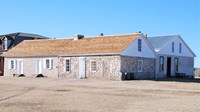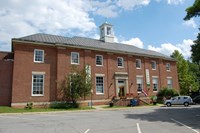- Lewis & Clark National Historic Trail (64)
- Santa Fe National Historic Trail (60)
- Fort Vancouver National Historic Site (25)
- Oregon National Historic Trail (23)
- Old Spanish National Historic Trail (20)
- Bent's Old Fort National Historic Site (19)
- Fort Union Trading Post National Historic Site (18)
- California National Historic Trail (17)
- Grand Portage National Monument (16)
- Show More ...
- Archeology Program (7)
- National Trails Office - Regions 6, 7, 8 (7)
- National Heritage Areas Program (6)
- National Historic Landmarks Program (6)
- Historic Preservation Training Center (4)
- National Center for Preservation Technology and Training (3)
- National Trails System (3)
- Youth Programs (3)
- Youth Programs Division (3)
- Show More ...
Showing 458 results for Traders ...
Rome Historical Society
- Type: Place
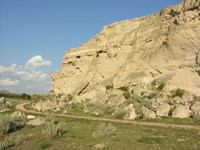
Following a day's journey from Fort Laramie, emigrants spent the night at Register Cliff , which rises one hundred feet above the North Platte River valley. The soft, chalky limestone rock made it easy for emigrants to inscribe their names into the cliff before continuing on their journey. The earliest signatures date to the late 1820s when trappers and fur traders passed through the area.
East Cape Campsite
- Type: Place

This campsite is an open shelly sand beach stretching for several miles along the Gulf of Mexico. Expect expansive sea views as well as magnificent sunsets and sunrises. Ruins of a dock used by an old concession tour may be found here. In the 1830s, Fort Poinsett was located here. Its mission was to thwart suspected arms trading between Indians and Spanish fisherman. Mosquitoes and sandflies may be a problem year round.
Fingerweaving
- Type: Article

Fingerweaving is the art of making material with the fingers instead of a loom. Prior to European contact Indigenous peoples in North America wove and twined with plants and animal fibers for a multitude of purposes. We know the beautiful, dense, warp-faced arrow and lightning motif sashes created by changing the weft that we associate with the Fur Trade are uniquely tied to North America.
Hiram Scott
- Type: Person

Scotts Bluff was a landmark for emigrants traveling the Oregon, California and Mormon Pioneer Trails. The story of the man whom the striking geologic feature was named after, was told countless times by travelers on the Great Platte River Road. Eventually, the story of Scott took on a life of its own and became an integral part of the emigrant experience.
Boggsville Historic Site
- Type: Place
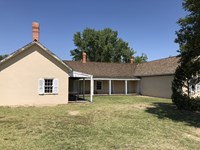
Boggsville was once a stage stop on the Santa Fe Trail. Key businesses there were trading stores, owned by Thomas O. Boggs (built in 1862) and John W. Prowers (built in 1867). Boggsville became the seat of Bent County in 1870, but the coming of the railroad to nearby Las Animas brought about the town's downfall by 1880.
Esther Lape
- Type: Person

Esther Lape was well known as a journalist, researcher, and publicist. She was also associated with the Women's Trade Union League and one of the founders of the League of Women Voters. Her life-partner was the scholar and lawyer, Elizabeth Read, who was Eleanor Roosevelt’s personal attorney and financial advisor.
Charles Bent
- Type: Person
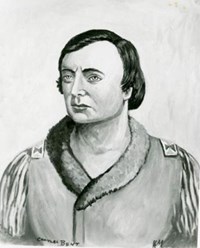
Charles Bent, alongside his partner, Ceran St. Vrain, and younger brother, William Bent, established the Bent, St. Vrain, and Company along the Santa Fe Trail in 1833. This adobe-constructed trading post beside the Arkansas River in southeastern Colorado was the first outpost between St. Louis, MO and Santa Fe, NM in its day. Charles and William's close association with Cheyenne and Arapaho nations enabled the company to prosper as a result of the buffalo robe trade.
Derby House
- Type: Place

Built in 1762 as a wedding present, this was the home of Elias Hasket Derby (1739-99) and Elizabeth Crowninshield Derby (1727-99) for the first 20 years of their marriage. They lived here with their seven children and enslaved at least two people of African descent. The Derby family became one of Salem’s wealthiest merchants, their wealth was tied to their trade in goods produced by slave plantations in the Caribbean Islands.
Francis Vigo
The Battle of Oriskany: "Blood Shed a Stream Running Down" (Teaching with Historic Places)
- Type: Article

By the time of the Revolutionary War, Dutch, German, Irish, Scotch, and British settlers prospered from lucrative trade and productive farms. Yet the whole area suffered from long-established prejudices and hatred between groups and individuals. When war broke out, European Americans and American Indians fought each other for control of New York's political power, land, and commerce. No episode better captures the brutal civil war than the Battle of Oriskany.
1799 Petition of Absalom Jones, and Others, People of Color, and Freemen Against the Slave Trade to the Coast of Guinea
Ken-Tuck-U-Inn
- Type: Place

As logging in the area faded, many local entrepreneurs looked for other ways to earn a living. Bertie Bancroft, who grew up in Aral, saw the growing tourist trade and built the Ken-Tuck-U-Inn. Bertie and his wife Donna operated the inn. Other farm inns were developing as the local economy was turning to serve the growing tourist industry. Produce grown on the farm was used to make meals for the guests, which was more valuable than selling it wholesale to local markets.
- Type: Article

In 2024, Alex Crawford worked as a Traditional Trades Advancement Program (TTAP) Landscape Stewardship Corps (LSC) intern at Medgar & Myrlie Evers Home National Monument. This internship gave him essential skills that led to him becoming a gardener at Petersburg National Battlefield. We caught up with him to hear about his experience, his background, and his work now as an NPS employee.
- Type: Place

More than 300-years of history are etched into the rural landscape of colonial forts, plantations, churches, cemeteries, and homes that comprise Cane River National Heritage Area. Historically, this region lay at the intersection of the French and Spanish Realms in the New World, with the town of Natchitoches originating as an important 18th century trade center.
- Type: Article
Sophie Millar recently worked as a Traditional Trades Advancement Program (TTAP) and TTAP Landscape Stewardship Corps (LSC) intern at the Home of Franklin D. Roosevelt National Historic Site and the Vanderbilt Mansion National Historic Site. This experience led her to a NPS position as a gardener at the White House and President's Park. We caught up with her to hear about her experience, her background, and her work now as an NPS employee.

